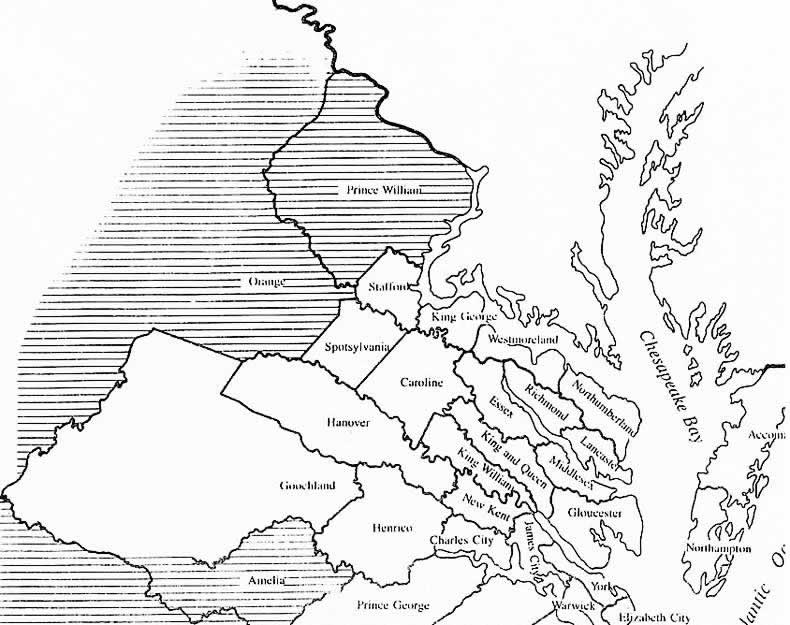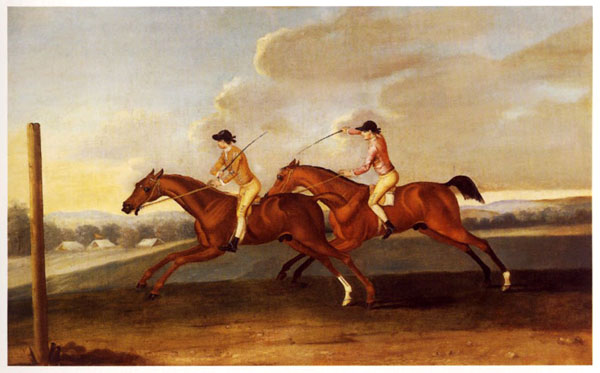The Colonial Courthouse and Court Days
Orange County, Virginia, as an Example
Since the only evidence of the lives of the early Virginia Milams is in court records, it could be useful to discuss the courthouse and court days. One might imagine that the courthouse was in a quaint village, like in New England, or Williamsburg for example. However, the only village in recently formed Orange County (1734) was the remnants of Germanna (link) where Lieutenant Governor Alexander Spotswood (link) (1710 - 1722) had imported German indentured servants to mine for iron ore in 1714.
When Colonel William Byrd II (link) visited Germanna on horseback in late September 1732, he noted in his diary that the village "consists of Colonel Spotswood´s enchanted castle on one side of the street and a baker´s dozen of ruinous tenements on the other, where so many German families had dwelt some years ago". [17]
 |
 |
In general, villages were few and far between in colonial Virginia. The closest village for Thomas Milam was Fredericksburg, 50 miles east in Spotsylvania County. A few days after Colonel Byrd II was in Germanna, he visited Colonel Henry Willis in Fredericksburg. Byrd observed "....the inhabitants are very few. Besides Colonel Willis.....there is only one merchant, a tailor, a smith, and an ordinary (link) keeper". [18] { This Henry Willis would become the first Clerk of Courts for Orange County. [109, 147] }
The main criteria for designating a new county was when it was more than one day's horseback ride to the courthouse for several Justices of the Peace (link). In July 1734, John Rucker and other Gentlemen petitioned the Spotsylvania Court for dividing the county. [138] The petition was ordered certified and sent to the General Assembly in Williamsburg (link) . On 20 September 1734, the General Assembly passed the following statue:
"Whereas divers inconveniences attended the upper inhabitants of Spotsylvania County, by reason of their great distance from the Courthouse...: Be it therefore enacted, by the Lieutenant Governor, Council and Burgesses, and this present Assembly, and it is hereby enacted by authority of the same; that from....the first day of January now next ensuing the said County of Spotsylvania be divided by the dividing line between the parish of St. George and the parish of St. Mark: and....all that territory adjoining to and above the said line, bounded....westerly by the utmost limits of Virginia, be henceforth erected into one distinct county, to be called and known by the name of the County of Orange....
A Court for the County was directed to be constantly held by the Justices thereof on the third Tuesday in every month.....For the encouragement of the inhabitants already settled and which shall speedily settle on the westward of the Sherrendo River, it was further enacted that they should be free and exempt from the payment of public, county and parish levies for three years next following, and that all who might settle there in the next three years should be so exempt for the remainder of that time." [232]
This map (image) shows the vast territory of the new County of Orange extending west across the Blue Ridge Mountains and Shenandoah Valley to the Appalachian Mountains and beyond.
 |
As a matter of course, the General Assembly provided some funds and ordered that the courthouse be located at the center of the new county for the convenience of the scattered population. Often this was in the middle of nowhere. Even today the crossroads nature of these locations remains in tiny communities like Amelia Court House, Charlotte Court House, King and Queen Courthouse, etc.
After the court for Orange County first met on 21 Jan 1734/1735, a debate ensued about the "center" of the county and where to locate the courthouse. [148] On 25 Nov 1736, the "Court agreed with John Bramham that he lease 20 acres of (his) land to this county to build a Courthouse.....for 120 pounds of tobacco per annum.....the plot should include a convenient spring to Cedar Island Ford..." [133, 134] At the same session, it was ordered that "...the Court for the County to be held at Mr. John Bramham December next..." [135] and, since the Court Justices needed a place to spend the night, that "John Bramham is given permission for an Ordinary at his own house..." [136] By 1741 his tavern was referred to in a court order as "Bramham's Great Ordinary". [296]
This is the same John Bramham who in the mid 1740s jointly held a warrant with Thomas Milam for 400 acres on the north side of Double Top Mountain. See their plats here (image) and this discussion (link) in the Court Records for Thomas Mylam. Since the new courthouse was not completed until late 1738, the suit against Thomas Mylam and Francis Williams was heard at John Bramham's house.
Although located at a crossroad among forests and fields, the county courthouse was not a solitary structure. There was always an associated Ordinary or two, a jail and eventually a store. Unlike the grand brick structures (image) in the established counties of the Tidewater, the frontier courthouses (image) like in the County of Orange were constructed of wood, much like the homes that I discuss in my article on Early Settlers' Houses which you may read here (link)
 |
In Colonial Virginia of the 17th and 18th centuries, fully 75% of arrivals from Britain and Germany arrived as indentured servants (link) - meaning that in return for someone paying their passage across the Atlantic Ocean, they contractually agreed to work without pay for 4 to 7 years. They received guarantees of work, hopefully training in some skill, food, lodging and one new set of clothes each year. When these indentured servants became free men, they had to start from scratch which meant leasing land and purchasing from merchants on an account to be paid at harvest time. Thus in Virginia county courts 80% of cases were for "debt". Colonial times in the mid-Atlantic tobacco producing colonies were very litigious!
The monthly Court Days were occasions for the men of the dispersed population to gather. The Justices of the Peace (link) and the Court acted as the legislative, executive and judicial authority for each county. They decided on the right of way of roads and ordered nearby citizens to clear them; made contracts for the construction of courthouses, bridges, jails, etc.; appointed Constables and Under-Sheriffs, road surveyors and tobacco inspectors; recommended men to the Governor for appointment as Sheriff, Clerk of Court, and militia officers; granted permission to construct and operate water grist mills, saw mills, ferries and Ordinaries (taverns); annually set the prices of beds, meals and alcoholic beverages at Ordinaries; approved Deeds and Wills; decided cases of debt and property rights; prosecuted those who broke the rules of the Church of England (lack of attendance, swearing profane oaths, fighting, adultery, having a bastard child); and oversaw the jury trials of civil and criminal cases.
You may view an Orange County court record of Grand Jury presentments for violating the proscriptions of the Church of England here (image) . Since literacy was very low, all legal papers like Deeds and Wills were read aloud and verbally acknowledged by the signers and witnesses. The legal system was English Common Law but because of illiteracy, the absence of free schools, and the forbidding of printing of the General Assembly’s Laws until around 1732 in practice it was an oral tradition. [295] As Robert Beverely described procedures: "determining every thing by the Standard of Equity and Good Conscience." Or in the words of Landon Carter: "decided by Good reason and Justice" - rather than precedents. [294] It was by attending court and hearing the papers, contracts and court rulings read that one came to understand authority and the law, one’s rights and one's obligations. [143]
Quotes from Col. William Byrd's diary again add color. Concerning his September 1732 visit to Col. Henry Willis, he noted: "It happened to be court day here, but the rain hindered all but the most quarrelsome people from coming. The Colonel brought three of his brother justices to dine with us, namely John Taliaferro, Major {John} Lightfoot, and Captain {Robert} Green....". [149] The latter three Gentlemen owned significant land in what would become Orange County and would be appointed Justices for the first Orange Court in early 1735. [148]
Continuing his horse ride home, two days later Col. Byrd visited Major Ben Robinson, Clerk of Court, for Caroline County. Of this visit he wrote "....the Major received us with his usual good humor. He has a very industrious wife, who has kept him from sinking by the weight of gaming and idleness. But he is now reformed from those ruinous qualities and by the help of the Clerk's place in a quarrelsome county will soon be able to clear his old scores {debts}."
Byrd described the following morning: "After that, Ben Robinson ordered his East Indian to conduct me to Colonel Martin's. In about ten miles we reached Caroline {county} courthouse, where Colonel Armistead and Colonel Will Beverley have each of 'em erected an Ordinary well supplied with wine and other polite liquors for the worshipful bench {justices}. Besides these, there is a rum ordinary for persons of more vulgar taste. Such liberal supplies of strong drink often make Justice nod and drop the scales out of her hands." [150] Note: that the Clerk of Court for Caroline County lived ten miles from the courthouse.
Attending the legal proceedings - as important as they were - was not the only reason men gathered for the court’s two day session each month. There was business to conduct, sales and loans to be made, games to watch and participate in and the activities of the Ordinary: comradery, telling stories, drinking, making boasts and toasts, games of dice and playing cards and rough wrestling.
In the wealthier, more established Tidewater counties of the Colony of Virginia, horse races especially the uniquely Virginian "quarter race" were a big attraction. Straight quarter mile race courses were prepared near the courthouse for such events. [144] Cock fights were popular in every county. [145] Wagering was active for all these events.
Rhys Isaac describes a "quarter race":
"At the start the two riders were accustomed to jockey for position, and when the starter’s signal sent them hurtling at full gallop down the narrow track, each might be free (depending on the agreed rules) to use whip, knee, or elbow to dismount his opponent or drive him off the track......These race meetings customarily adjourned to the nearby Ordinary, where participants were further entertained by bouts of ferocious wrestling....." [146]
 |
-------------------------------------------------------------------------------------
NOTE TO READERS: All the words in bold type face are links to images, maps or word definitions in the Glossary. The Citations and Glossary are available under the Resources tab or here (link) .
